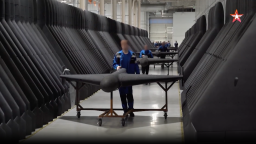Science
Russia’s Drone Factory Expands, Marginalizing Iran’s Role

Russia has ramped up production of Iranian-designed drones at its Alabuga factory, effectively sidelining Iran in the process. The facility, located approximately 600 miles east of Moscow in Tatarstan, has been increasingly manufacturing the Shahed-136 attack drone, which is known as Geran in Russia. This development signals a shift in the relationship between Moscow and Tehran, as Russia moves toward greater self-sufficiency in drone production.
In a recent documentary, Timur Shagivaleev, CEO of the Alabuga facility, highlighted the factory’s capabilities. He noted that it is now a “complete facility,” producing most components locally. “Aluminium bars come in, engines are made from them; microelectronics are made from electric chips,” he explained. Analysts believe that around 90% of the production stages for the Shahed-136 now occur at Alabuga or other Russian sites.
Recent satellite imagery has revealed ongoing expansions at Alabuga, including new production facilities and accommodations for workers. This growth could enable Russia to export an upgraded version of the drone back to Iran, potentially allowing Tehran access to a more advanced and battle-tested product.
Yet, a Western intelligence source indicates that this expansion has marginalized Iran, leading to tensions in their partnership. Tehran is reportedly frustrated by the lack of substantial returns from its collaboration with Moscow, despite providing drones and other military assets to support Russia’s military actions in Ukraine. “Iran may have expected Russia to do more,” said Ali Akbar Dareini, an analyst at the Tehran-based Center for Strategic Studies.
The dynamic has become more complicated following Israel’s bombing campaign targeting Iranian nuclear facilities in June. During this conflict, Russia’s response was viewed as inadequate by Iran, further straining their relationship. Dareini suggests that while Iran may not intervene militarily, it could enhance operational support through increased weapon shipments and technology transfers.
Following Russia’s full-scale invasion of Ukraine in February 2022, the country began importing Shahed drones from Iran. By early 2023, a $1.75 billion agreement was reached for Russia to produce the drones domestically, with an initial order of 6,000 units set to be completed by September 2025. Reports indicate that production has significantly exceeded expectations, with Alabuga now manufacturing more than 5,500 drones each month.
In addition to increasing production, Russia has made improvements to the Shahed drones, enhancing their capabilities with better communications, longer battery life, and larger warheads. This evolution has reportedly caught Iranian officials off guard, leading to a gradual loss of control over the final product.
Dareini emphasizes the dual nature of the relationship between Russia and Iran, describing it as a mix of cooperation and competition. “Russians want more while giving less,” he stated, noting that Iran has provided significant support but has not received commensurate benefits in return.
Financial grievances have also surfaced, with Iranian authorities and companies, such as Sahara Thunder, expressing concerns over unpaid debts. This situation is exacerbated by the international sanctions that have affected the Russian economy, complicating financial transactions.
As tensions rise, some experts believe that Russia’s expansion at Alabuga could allow Moscow to provide meaningful support to Iran, particularly in rebuilding its drone capabilities after recent attacks. David Albright, a former UN weapons inspector, mentioned that as Iran seeks to replenish its stock, it may receive updated drones from Russia, potentially enabling reverse engineering of the technology.
Military cooperation continues, as evidenced by a recent flight from Moscow to Tehran on July 11, 2023, involving a military cargo plane believed to have transported components of a Russian S-400 air defense system. While the exact contents remain unconfirmed, this development underscores ongoing military ties between the two nations.
Despite the emerging rift, Dareini maintains that Iran will ultimately benefit from its partnership with Russia. “Iran has got, and very likely will get, the things it needs for its own security,” he concluded, whether in military hardware, economic cooperation, or technology. This relationship, while complex, continues to evolve amid shifting geopolitical landscapes.
-

 Lifestyle2 weeks ago
Lifestyle2 weeks agoLibraries Challenge Rising E-Book Costs Amid Growing Demand
-

 Lifestyle1 week ago
Lifestyle1 week agoSave Your Split Tomatoes: Expert Tips for Gardeners
-

 Sports1 week ago
Sports1 week agoLiverpool Secures Agreement to Sign Young Striker Will Wright
-

 Lifestyle1 week ago
Lifestyle1 week agoPrincess Beatrice’s Daughter Athena Joins Siblings at London Parade
-

 Sports7 days ago
Sports7 days agoTyreek Hill Responds to Tua Tagovailoa’s Comments on Team Dynamics
-

 Science2 weeks ago
Science2 weeks agoTom Lehrer, Pioneering Satirist and Musician, Dies at 97
-

 World6 days ago
World6 days agoWinter Storms Lash New South Wales with Snow, Flood Risks
-

 World2 weeks ago
World2 weeks agoSwingathon Festival Draws Nearly 1,000 Attendees in Allington
-

 Lifestyle2 weeks ago
Lifestyle2 weeks agoNigeria Claims 10th African Championship Title with Victory Over Morocco
-

 Politics2 weeks ago
Politics2 weeks agoNorth Dakota Woman Dies in Lake Crash Following Highway Incident
-

 Science2 weeks ago
Science2 weeks agoTrump Administration Moves to Repeal Key Climate Regulation
-

 Business2 weeks ago
Business2 weeks agoSoFi Technologies Shares Slip 2% Following Insider Stock Sale









